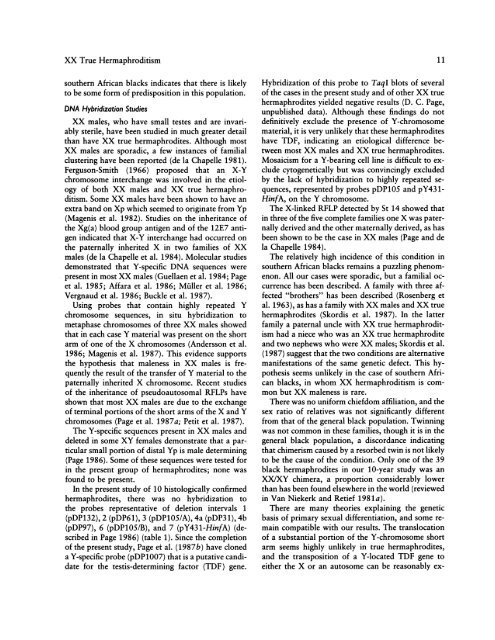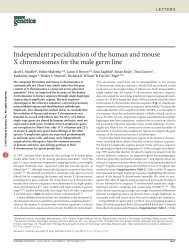XX True Hermaphroditism in Southern African Blacks - david page ...
XX True Hermaphroditism in Southern African Blacks - david page ...
XX True Hermaphroditism in Southern African Blacks - david page ...
- No tags were found...
You also want an ePaper? Increase the reach of your titles
YUMPU automatically turns print PDFs into web optimized ePapers that Google loves.
<strong>XX</strong> <strong>True</strong> <strong>Hermaphroditism</strong>southern <strong>African</strong> blacks <strong>in</strong>dicates that there is likelyto be some form of predisposition <strong>in</strong> this population.DNA Hybridization Studies<strong>XX</strong> males, who have small testes and are <strong>in</strong>variablysterile, have been studied <strong>in</strong> much greater detailthan have <strong>XX</strong> true hermaphrodites. Although most<strong>XX</strong> males are sporadic, a few <strong>in</strong>stances of familialcluster<strong>in</strong>g have been reported (de la Chapelle 1981).Ferguson-Smith (1966) proposed that an X-Ychromosome <strong>in</strong>terchange was <strong>in</strong>volved <strong>in</strong> the etiologyof both <strong>XX</strong> males and <strong>XX</strong> true hermaphroditism.Some <strong>XX</strong> males have been shown to have anextra band on Xp which seemed to orig<strong>in</strong>ate from Yp(Magenis et al. 1982). Studies on the <strong>in</strong>heritance ofthe Xg(a) blood group antigen and of the 12E7 antigen<strong>in</strong>dicated that X-Y <strong>in</strong>terchange had occurred onthe paternally <strong>in</strong>herited X <strong>in</strong> two families of <strong>XX</strong>males (de la Chapelle et al. 1984). Molecular-studiesdemonstrated that Y-specific DNA sequences werepresent <strong>in</strong> most <strong>XX</strong> males (Guellaen et al. 1984; Pageet al. 1985; Affara et al. 1986; Miller et al. 1986;Vergnaud et al. 1986; Buckle et al. 1987).Us<strong>in</strong>g probes that conta<strong>in</strong> highly repeated Ychromosome sequences, <strong>in</strong> situ hybridization tometaphase chromosomes of three <strong>XX</strong> males showedthat <strong>in</strong> each case Y material was present on the shortarm of one of the X chromosomes (Andersson et al.1986; Magenis et al. 1987). This evidence supportsthe hypothesis that maleness <strong>in</strong> <strong>XX</strong> males is frequentlythe result of the transfer of Y material to thepaternally <strong>in</strong>herited X chromosome. Recent studiesof the <strong>in</strong>heritance of pseudoautosomal RFLPs haveshown that most <strong>XX</strong> males are due to the exchangeof term<strong>in</strong>al portions of the short arms of the X and Ychromosomes (Page et al. 1987a; Petit et al. 1987).The Y-specific sequences present <strong>in</strong> <strong>XX</strong> males anddeleted <strong>in</strong> some XY females demonstrate that a particularsmall portion of distal Yp is male determ<strong>in</strong><strong>in</strong>g(Page 1986). Some of these sequences were tested for<strong>in</strong> the present group of hermaphrodites; none wasfound to be present.In the present study of 10 histologically confirmedhermaphrodites, there was no hybridization tothe probes representative of deletion <strong>in</strong>tervals 1(pDP132), 2 (pDP61), 3 (pDP105/A), 4a (pDP31), 4b(pDP97), 6 (pDP105/B), and 7 (pY431-H<strong>in</strong>fA) (described<strong>in</strong> Page 1986) (table 1). S<strong>in</strong>ce the completionof the present study, Page et al. (1987b) have cloneda Y-specific probe (pDP1007) that is a putative candidatefor the testis-determ<strong>in</strong><strong>in</strong>g factor (TDF) gene.11Hybridization of this probe to TaqI blots of severalof the cases <strong>in</strong> the present study and of other <strong>XX</strong> truehermaphrodites yielded negative results (D. C. Page,unpublished data). Although these f<strong>in</strong>d<strong>in</strong>gs do notdef<strong>in</strong>itively exclude the presence of Y-chromosomematerial, it is very unlikely that these hermaphroditeshave TDF, <strong>in</strong>dicat<strong>in</strong>g an etiological difference betweenmost <strong>XX</strong> males and <strong>XX</strong> true hermaphrodites.Mosaicism for a Y-bear<strong>in</strong>g cell l<strong>in</strong>e is difficult to excludecytogenetically but was conv<strong>in</strong>c<strong>in</strong>gly excludedby the lack of hybridization to highly repeated sequences,represented by probes pDP105 and pY431-H<strong>in</strong>fA, on the Y chromosome.The X-l<strong>in</strong>ked RFLP detected by St 14 showed that<strong>in</strong> three of the five complete families one X was paternallyderived and the other maternally derived, as hasbeen shown to be the case <strong>in</strong> <strong>XX</strong> males (Page and dela Chapelle 1984).The relatively high <strong>in</strong>cidence of this condition <strong>in</strong>southern <strong>African</strong> blacks rema<strong>in</strong>s a puzzl<strong>in</strong>g phenomenon.All our cases were sporadic, but a familial occurrencehas been described. A family with three affected"brothers" has been described (Rosenberg etal. 1963), as has a family with <strong>XX</strong> males and <strong>XX</strong> truehermaphrodites (Skordis et al. 1987). In the latterfamily a paternal uncle with <strong>XX</strong> true hermaphroditismhad a niece who was an <strong>XX</strong> true hermaphroditeand two nephews who were <strong>XX</strong> males; Skordis et al.(1987) suggest that the two conditions are alternativemanifestations of the same genetic defect. This hypothesisseems unlikely <strong>in</strong> the case of southern <strong>African</strong>blacks, <strong>in</strong> whom <strong>XX</strong> hermaphroditism is commonbut <strong>XX</strong> maleness is rare.There was no uniform chiefdom affiliation, and thesex ratio of relatives was not significantly differentfrom that of the general black population. Tw<strong>in</strong>n<strong>in</strong>gwas not common <strong>in</strong> these families, though it is <strong>in</strong> thegeneral black population, a discordance <strong>in</strong>dicat<strong>in</strong>gthat chimerism caused by a resorbed tw<strong>in</strong> is not likelyto be the cause of the condition. Only one of the 39black hermaphrodites <strong>in</strong> our 10-year study was an<strong>XX</strong>/XY chimera, a proportion considerably lowerthan has been found elsewhere <strong>in</strong> the world (reviewed<strong>in</strong> Van Niekerk and Retief 1981a).There are many theories expla<strong>in</strong><strong>in</strong>g the geneticbasis of primary sexual differentiation, and some rema<strong>in</strong>compatible with our results. The translocationof a substantial portion of the Y-chromosome shortarm seems highly unlikely <strong>in</strong> true hermaphrodites,and the transposition of a Y-located TDF gene toeither the X or an autosome can be reasonably ex-



